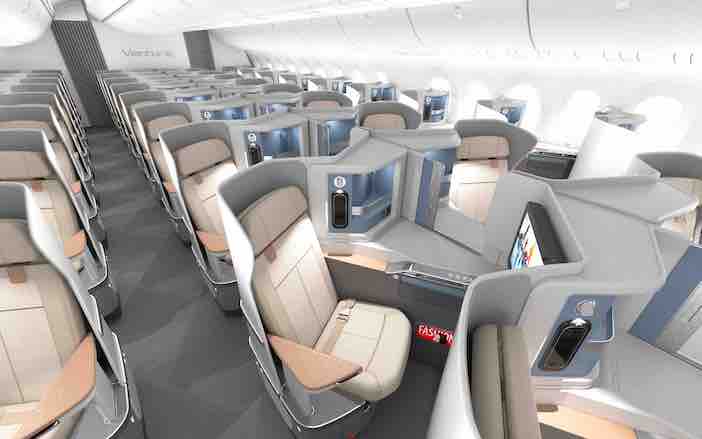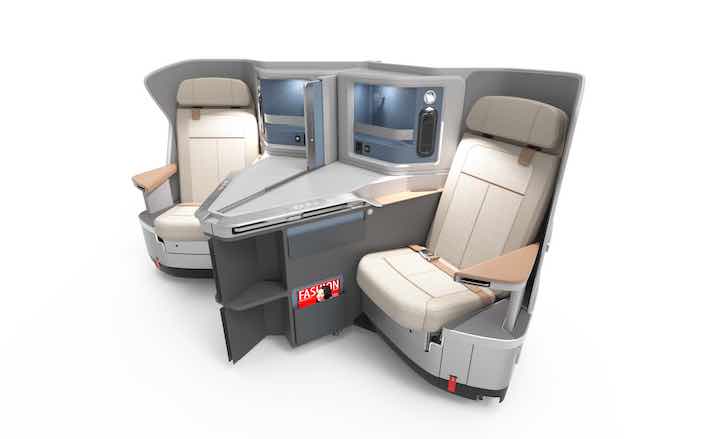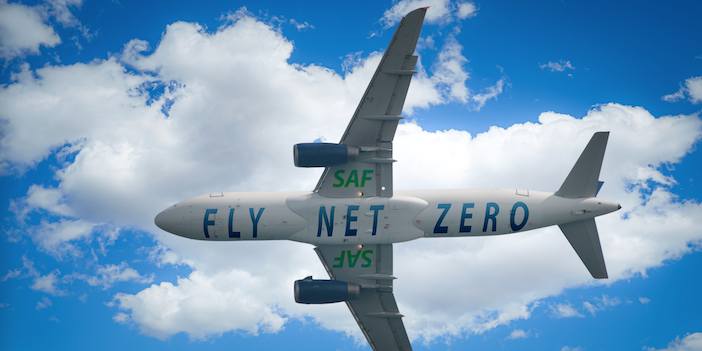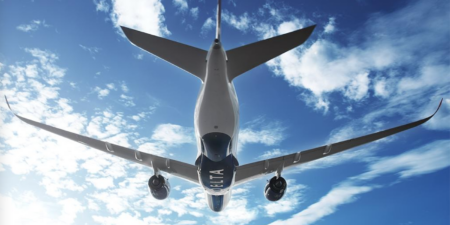The airline industry faces strong headwinds during the next decade as policymakers and the general public raise concerns about the environmental impact of air travel.
Aviation has responded with the commitment to achieve Net Zero emissions by 2050, pursuing many strategies to reach this ambitious goal, including investing in modern aircraft with fuel-efficient engines, optimising flight plans, converting to sustainable aviation fuel (SAF), and developing novel propulsion systems that use hydrogen and electric power.
These strategies are not without costs and risks, and some of these solutions remain speculative, beyond the foreseeable horizon, with complexities and details to be worked out over the next decade or more.
Lightweight cabin interiors
While many airlines are pursuing all of the above approaches to sustainability, one strategy has been proven to significantly reduce fuel consumption and greenhouse gas emissions, with few downsides: reducing weight. In particular, airlines are increasingly choosing state-of-the-art, lightweight aircraft interiors as a cost-effective solution for lowering fuel costs and emissions.
Reduced weight is important, and the interiors account for about 10% of the empty weight of an aircraft – but that is only part of the story. In addition to lowering fuel consumption, well-designed aircraft interior systems also produce other operational savings by requiring less cleaning, and fewer spare parts and repairs.
interiors account for about 10% of the empty weight of an aircraft”
Moreover, airlines are increasingly considering the indirect, non-operational impact on the environment. The cabin interior is replaced four to five times during the life of the airframe, raising the importance of ensuring that the manufacturing of the interior systems, as well as the end-of-life handling, is consistent with the airline’s sustainability goals.
The environmental impact of the airline industry
Let’s look deeper into the environmental impact of the airline industry and the role of new aircraft interiors as one of the solutions. A study by the European Parliament found that in 2019, aviation accounted for 3.8% of the EU’s total greenhouse gas emissions and that the sector was the fastest-growing source of emissions that contribute to climate change, increasing by 146% since 1990.
The continuing growth in global airline traffic compounds the challenges. The commercial aviation industry projects annual growth of between 3.1% (ICAO) and 3.6% (ATAG) revenue passenger-kilometres through 2050, and studies by Airbus and Boeing forecast 3.9- 4.0% annual growth through 2040.
Pressure on the airline industry to address sustainability is intensified by disparities in identifying who causes, and who is affected by, climate change. According to the International Energy Agency, ‘around 90% of the global population flies only once a year or not at all, whereas around 6% fly more than twice a year, and just 1% fly more than five times a year…. As such, in some regions, the top decile’s emissions from aviation are higher than the bottom decile’s entire footprint.”
The pressure is coming from all directions, from government agencies, from customers, as well as from stockholders and employees. Airlines are taking affirmative actions to make their operations sustainable, and they are also conducting marketing and public relations campaigns to address these concerns.
Sustainable Aviation Fuel
For example, American Airlines recently announced it would purchase 100 million gallons of Sustainable Aviation Fuel (SAF) annually, starting in 2027. The International Air Transport Association (IATA) estimates that global SAF production tripled from 2021 to 2022, to 300 million litres. To date, a half million commercial flights have been operated using SAF, even though it costs 2-4 times more to buy than conventional fuel.
Airlines have not been shy about these developments. United Airlines ‘hired’ the Muppets character, Oscar the Grouch, to lead a multi-media campaign as its Chief Trash Officer, turning plants and waste material (trash) into more environmentally friendly fuel. United boasted that as of the end of 2022, it has invested more in SAF than any other airline.
SAF is worth pursuing. But SAF alone cannot solve the industry’s sustainability challenges. A study from the University of California, Irvine claims that meeting the aviation industry’s fuel needs would require as much as 3 million square kilometres of land for biofuel crops, which is equivalent to one-third of the size of the USA. Even if SAF completely replaced petroleum-based fuels, IATA calculates it would contribute only around 65% of the reduction in emissions needed by aviation to reach the goal of net-zero by 2050.

The influence of aircraft interiors
That brings us back to airline interiors. Lightweight interiors are an effective method of reducing fuel consumption and emissions. These reductions may be modest in absolute terms compared to other strategies, such as investing in new aircraft (replacing an older aircraft with an Airbus A320neo narrowbody or a Boeing 787-9 widebody can reduce an airline’s emissions by 30% and 50%). However, choosing lightweight interior options costs a tiny fraction of the cost of the aircraft. These options produce reductions in emissions and fuel expenses at relatively little cost – a high return on investment with no risks or downsides.
Lighter seats and other weight-reduction practices can generate fuel savings between 0.65 and 0.85%, according to a March 2022 study by the Operations Sub Group of the International Civil Aviation Organization. The savings run into the billions of dollars for airlines, which are forecast to spend US$229.3 billion on fuel in 2023 (IATA figures). And the savings more than double for SAF, which is much more expensive compared to conventional fuel.
CBS News reported that “just changing the paper stock on United’s in-flight magazine saved one ounce per copy, saving nearly $300,000 a year.” Lighter cabins will save much more.
Why is sustainability especially important for cabins?
Pound for pound, lower weight is important for any part of the plane and its contents. But the environmental sustainability of cabins has added value, from a customer point of view.
The Aerospace Technology Institute emphasised this point in 2022, in a report titled Sustainable Cabin Design, New Approaches in Sustainable Aircraft Interior Design. “As public expectations for corporate environmental responsibility rise, the incentive for airlines to demonstrate their sustainability credentials through the passenger experience design will increase,” read the report.
“The cabin has a unique value as a marketing asset. It is the only part of the aircraft that is directly engaged with for long periods by the passengers whose ticket revenues fund the industry.”
The cabin is the most significant part of the plane, from a passenger’s point of view. Marketing and public relations campaigns promoting the sustainability of the aircraft interior resonate with customers.
Sustainable interiors also help to mitigate customer concerns about the environmental impact of premium seating. The first class and business class cabins take up more floor area per seat on an airplane than economy seating, accounting for a larger share of the fuel burn, but premium seating can be highly profitable for the airline. The International Council on Clean Transportation estimates that a passenger in first class and business classes emits 2.6 to 4.3 times more CO2 per kilometre than a passenger in economy class. These figures may exaggerate the impact at airlines that fill premium seats with complimentary upgrades for frequent flyers.
Substantial fuel savings and emission reductions
The Venture premium-class seat from Jamco Corporation exemplifies various ways that interiors contribute to an airline’s sustainability goals through weight savings. Manufactured from advanced patented panel composites, metal alloys, and plastics, the Venture seats are lighter than traditional seats while also providing improved durability and maximum comfort. The design of Venture prioritises reduced part count and minimises decorative surfaces, resulting in a lightweight structure.

For example, on a typical wide-body aircraft, replacing older-style business-class seats with the Venture seat could result in a single aircraft weight savings of over 900 pounds (408kg). The weight reduction translates to a fuel savings of over 40 gallons per flight, over 700 gallons per month, and over 8,500 gallons per year (assuming 28 Venture seats on a Boeing 787 aircraft, running four 10 hour flights per week). A programme of 17 shipsets over an eight-year service life would result in 1 million fewer gallons of fuel consumed.
In addition to reduced fuel consumption, the seat design is engineered to lower operating costs by reducing spares inventory requirements, as well as seat maintenance labour and supplies, compared to traditional seat designs.
Sustainability for the full lifecycle
The sustainability of aircraft interiors goes beyond the operational efficiencies of reducing emissions, fuel consumption and maintenance. Airlines are looking for solutions and suppliers that fully align with all aspects of their sustainability strategies. This means evaluating the entire lifecycle, from the manufacturing process through the end of service life. For example, utilising extrusion and casting manufacturing, which are forms of net-shape manufacturing, can significantly reduce environmental impact by minimising the amount of material required and substantially decreasing waste.
Both processes are energy efficient, reduce the amount of raw material consumed, do not produce harmful emissions, and do not require the use of toxic chemicals or large amounts of water (and are used for Venture seats). Additionally, the minimal chips created through the machining process are compressed into compact pucks, designed for easy transport and recycling. This compression process also facilitates the reclamation and repeated reuse of the machine coolant.
Sustainability also involves the design of products built to last, but eventually products need to be retired from service. For example, when the airline chooses to retire Venture seats from service, over 62% by weight of the product can be recycled, including over 70% of the seat structure assembly.
The inside story
Aircraft cabins play a key role in the sustainability of the airline industry. Choosing interiors with low environmental impact achieves high return on investment, with fuel savings and other operational and nonoperational benefits. And eco-friendly interiors are visible expressions of the airline’s commitment to a greener planet.
Jeremy Hunter is director of sales & marketing at Jamco America





